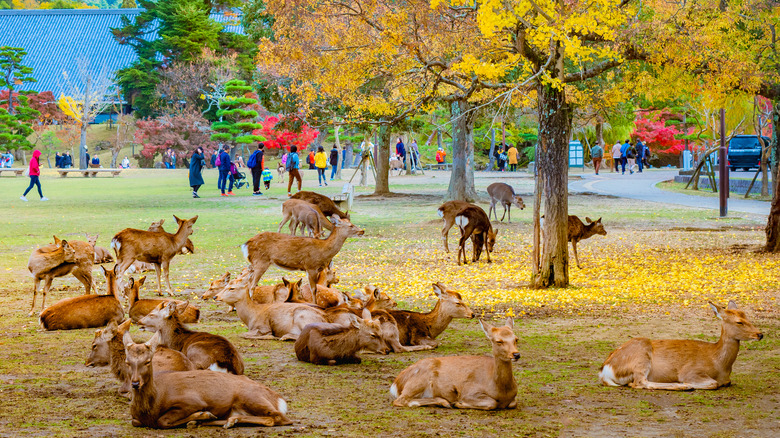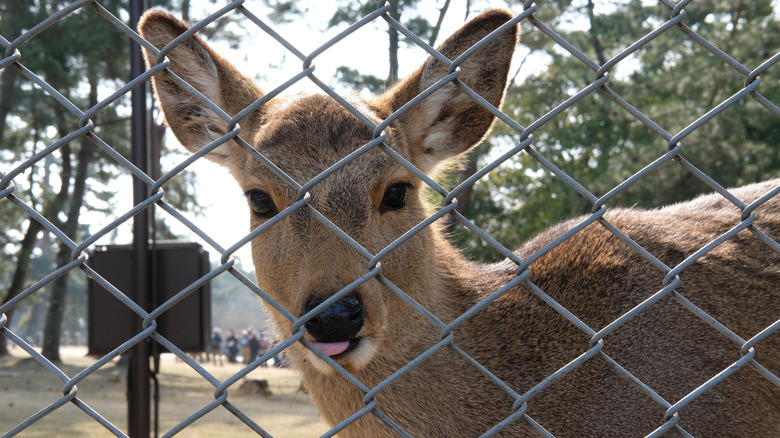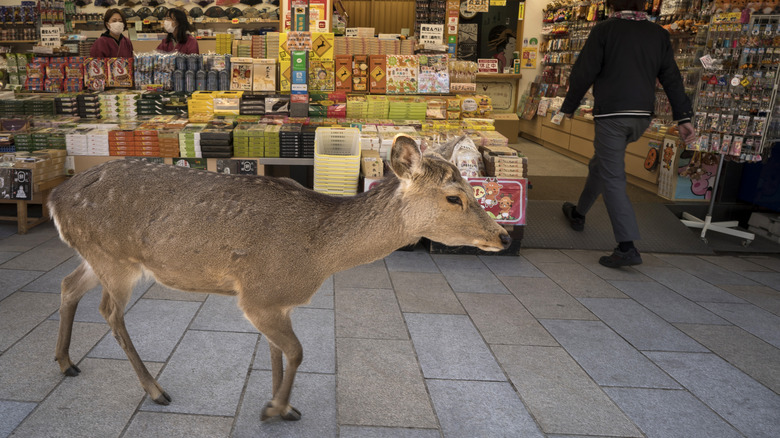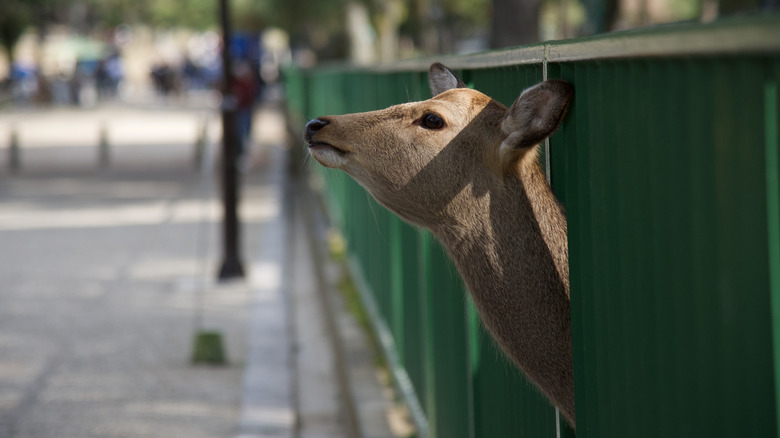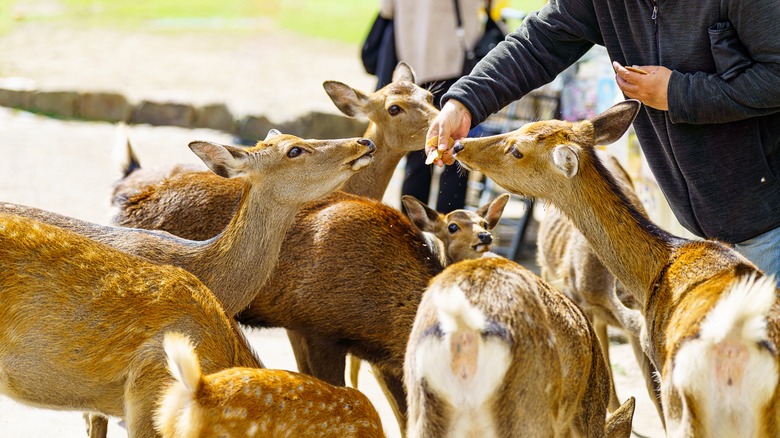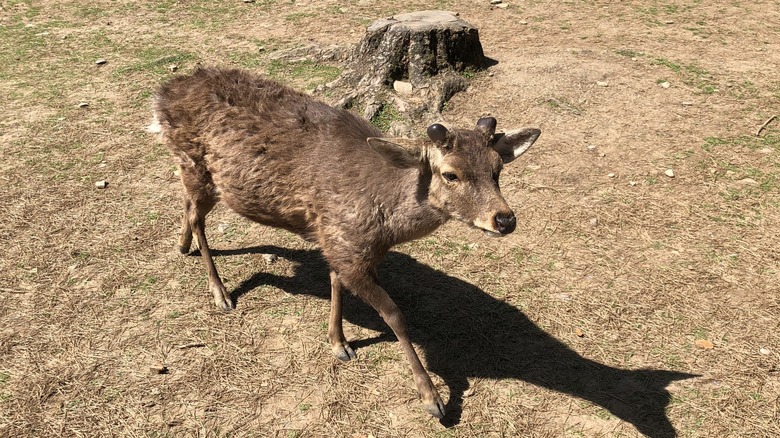Some Tourists May Want To Avoid Visiting Nara, Japan's Iconic But Controversial Deer Park
If you're an animal lover visiting Japan, the wild urban deer of Nara Park may engender mixed feelings. On the one hand, it can be a real highlight fraternizing with 1,000-plus sika deer in a public park. In Nara, they're sacred animals with National Treasure status, and they've become a part of everyday city life, spilling into the streets and even bowing to visitors in the polite Japanese way. On the other hand, these same deer risk being culled if they wander too far from the officially designated protection zone and cause crop damage on outlying farms.
Nara served as Japan's first permanent capital from A.D. 710 to 784. As a UNESCO World Heritage Site, the Historic Monuments of Ancient Nara — including Tōdaiji Temple and its famous Great Buddha Hall — exude rich culture. Today, the city is like Miyajima, a beautiful island where hundreds of friendly deer roam freely.
For many, this helps make Nara an unmissable tourist destination in Japan. On Tripadvisor, where it's noted that Nara Park "meets animal welfare guidelines," the park received a 2023 Travelers' Choice award, given to places that "consistently earn great reviews from travelers." Conversely, the same year, headlines painted a less idyllic picture of Nara as a place where the deer population is out of control and animals don't always receive humane treatment. There's a dark side to Nark Park and its deer shelter, Rokuen, and it's worth examining that if you're on the fence about whether to visit this place.
Nara Park and Rokuen
Speaking of fences, some deer in Nara Park are kept in captivity behind them. This may not be readily apparent if you're just passing through on your way to Tōdaiji Temple. The most direct pedestrian route from Kintetsu Nara Station to Tōdaiji takes you straight through the 1,240-acre park. To avoid the park altogether, you'd have to give it a wide berth and walk all the way around it en route to the popular temple.
Either way, you'd miss Rokuen, which is in the opposite direction from Tōdaiji. It's where the Nara Deer Preservation Foundation is tasked with caring for deer that have strayed beyond the park's protection zone. Since these animals are never set free again, it would be easy to think they're imprisoned for life in deer jail. Yet, visitors focused on the free-roaming deer might not even realize this shelter exists.
I've been to the park more than once since I moved to Japan in 2010 when Nara commemorated its 1300th anniversary as the one-time capital. My last visit there in the spring of 2023 was especially memorable. The weather was excellent, the deer seemed healthy, and I could see why Nara is one of the best spots to view gorgeous cherry blossoms in the Kansai region. Months later, however, disturbing reports surfaced in Japan-based news outlets like NHK, The Mainichi, and The Asahi Shimbun, casting Nara Park in a less favorable light.
The sad fate of stray deer
Outside the protection zone in Nara Park, there's also a buffer zone where the Nara Deer Preservation Foundation rounds up stray deer. Beyond that is the management or control zone, where the culling of as many as 180 deer per year is permitted. Words like "management" and "culling" are euphemisms for killing the deer to prevent agricultural damage and other problems. These words soften the impact of what's become an unfortunate fact of life in Nara, where some deer are put down or euthanized the way stray dogs would be at the pound in America.
In November 2023, as reported in The Asahi Shimbun, a veterinarian at Rokuen came forward as a whistleblower, alleging that dozens of deer a year were also dying of starvation inside the overcrowded facility. Photos emerged of emaciated deer with their ribs showing. The Nara Deer Preservation Foundation contended that the deer were fed but refused to eat food touched by human hands.
Nara's prefectural government, which entrusted the deer's care to the foundation, indicated it may have been understaffed and underbudgeted, ill-equipped to provide animals with the best living conditions. An investigation determined that the deer were not being abused, but in April 2024, the government expanded the culling area, making the buffer zone smaller and allowing more deer to be killed. Needless to say, the institutionalized killing of malnourished deer contrasts significantly with the image of Nara Park's well-fed animals, happily coexisting with human tourists.
The dark side of Nara Park
In my visits to Nara Park, I've never personally witnessed anything that would refute all those positive Tripadvisor reviews. However, the news of what's been happening behind the scenes has made me wonder if I was only seeing the park's public face — what you'd call the "tatemae" in Japanese. Rokuen and its holding fences are a short walk from Kasuga Shrine, where the tradition of deer as messengers of the gods originates. Yet, it seems like there's a disconnect between them in this city where the animals are selectively sacred, and deer population control is a matter of public policy.
Add to this the toxic fumes of social media, where users adopt subjective opinions about Nara Park secondhand, and hyperbolic statements circulate freely. The month before Congress voted to ban TikTok as a national security threat in the U.S., you could hear one influencer on there insisting, "No one should go to Nara Deer Park." Sentiments like that, coupled with the news, can lead to some cognitive dissonance if you've actually visited the park firsthand and found it lovely.
That's not to suggest every Nara Park deer encounter will be a surefire positive experience. Like the deer of Miyajima, some of the animals here can be aggressive about nipping at anything that halfway resembles food — even a camera strap. Tourists can also provoke the deer with obnoxious behavior and endanger them with the wrong food, including litter.
The impact of humans on Nara's deer
In 2019, nine deer died after eating plastic bags and food wrappers in Nara Park. In 2020, the reduction in tourists due to the pandemic also had a noticeable effect on the deer, as they were fed less "shika senbei," and their droppings returned to normal. Shika senbei are sugar-free crackers made with rice bran, wheat flour, and edible wrappers, so they're safe for the deer to consume, even by accident.
In 2021, the Nara Deer Preservation Foundation campaigned for people not to feed the deer anything besides the crackers. Vendors in the park sell them as snacks, but they're meant to be eaten in moderation. The deer are more naturally accustomed to grazing on grass, fallen leaves, and acorns. If they eat too many crackers, they become thirsty, drink more water, and get diarrhea. You could say overtourism has literally been a diarrhea stain on the grounds of Nara Park.
Meanwhile, the juxtaposition between overfed, free-roaming deer and captured, starving ones almost leaves the park feeling like an animal microcosm of the haves and have-nots in human society. Against this backdrop, it could be a turn-off to see tourists use Nara Park as their vacation playground, "a petting zoo on steroids," as one visitor described it to Indiana broadcaster WTHR. It's worth mentioning that, in other parts of Japan, "sacred" deer are hunted rather than petted, with venison curry and wild game meat being local specialties of some of the lakes near Mount Fuji.
Antler cutting and changing perceptions
Every October, Rokuen hosts Shika no Tsunokiri, a public deer antler-cutting ceremony. It's a tradition over 350 years old and is said to keep the deer from hurting each other and tourists. Still, some animal lovers might object to it on principle, the way others might disagree with declawing domesticated cats. It doesn't help that the deer are herded into an arena to have their antlers cut in a public spectacle.
Outside the TikTok school of travel, life in Nara Park rolls on, but it's impossible to deny that this busy sightseeing spot has picked up some bad buzz even in mainstream news. It has altered my rose-colored perception of the park and made me want to revisit it less as a tourist and more as an observer, paying closer attention to details I missed. If you're someone with strong feelings about the ethical treatment of animals, you may already be more attuned to signs of their well-being.
For some, just hearing that deer are being culled in certain areas might leave you with a bell you can't unring in your head about Nara. If you think you'd be offended by any hint of trouble in paradise, you might want to steer clear of the city's deer park or skirt it as much as you can. At the very least, it helps to know the good and the bad so you can make your own informed travel decision about Nara Park.
